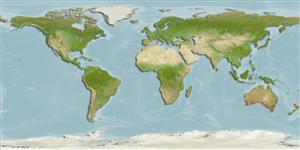Common names from other countries
Environment: milieu / climate zone / depth range / distribution range
Ecologie
marien; brak water; diepte 0 - 20 m (Ref. 6390). Temperate; 27°S - 44°S
Eastern Indian Ocean: Endemic to Australian temperate waters (Murchison River, Kalbarri in Western Australia to Eden, New South Wales, including Tasmania).
Lengte bij maturiteit / Grootte / Gewicht / Leeftijd
Maturity: Lm ?, range 25 - ? cm
Max length : 52.0 cm SL mannelijk / geslacht onbekend; (Ref. 10988); max. gepubliceerd gewicht: 600.00 g (Ref. 6390); max. gerapporteerde leeftijd: 10 Jaren (Ref. 27011)
Dorsale stekels (totaal): 0; Dorsale zachte stralen (totaal): 15-18; Anale stekels 0; Anale zachte stralen: 17 - 20; Wervels: 55 - 61. Gill rakers usually 33 or less on the first arch and usually 26 or less on the second arch. Relatively shorter upper and lower jaw, especially at larger sizes.
Found inshore in surface waters of estuaries, bays, inlets and gulfs to a depth of about 20 m (Ref. 9563). In the South Australian gulfs, southern sea garfish may be found in deeper waters during the colder months (Ref. 27008). Generally herbivorous, seagrasses and algal filaments comprise about 75% of their food (Refs. 26551, 27013). Form schools, generally found near the surface at night and close to the bottom over seagrass beds during the day (Ref. 6390). Post-larvae or young fish less than 1-year-old live in estuaries from March to July then move to inshore marine waters, remaining there for up to 2 years (Ref. 27012).
Collette, B.B., 1974. The garfishes (Hemiramphidae) of Australia and New Zealand. Records of the Australian Museum 29(2):11-105. (Ref. 10988)
Status op de Rode Lijst van het IUCN (Ref. 130435)
CITES (Ref. 128078)
Not Evaluated
Gevaar voor de mens
Harmless
Gebruik door de mens
Visserij: commercieel; aas: usually
Meer informatie
ReferentiesAquacultuurAquacultuurprofielKweeklijnenGeneticaElectrophoresesErfelijkheidZiektesVerwerkingMassaconversie
Tools
Speciale rapporten
Download XML
Internetbronnen
Estimates based on models
Preferred temperature (Ref.
115969): 14.3 - 22.3, mean 17.6 (based on 324 cells).
Fylogenetische diversiteitsindex (Ref.
82804): PD
50 = 0.5000 [Uniqueness, from 0.5 = low to 2.0 = high].
Bayesian length-weight: a=0.00257 (0.00115 - 0.00574), b=3.09 (2.91 - 3.27), in cm Total Length, based on LWR estimates for this Genus-body shape (Ref.
93245).
Trofisch niveau (Ref.
69278): 2.7 ±0.27 se; based on food items.
Weerstandsvermogen (Ref.
120179): Gemiddeld, minimale populatieverdubbelingstijd 1,4-4,4 jaar (K=0.51-0.77; tm=2-3; tmax=10).
Fishing Vulnerability (Ref.
59153): Low to moderate vulnerability (28 of 100).
